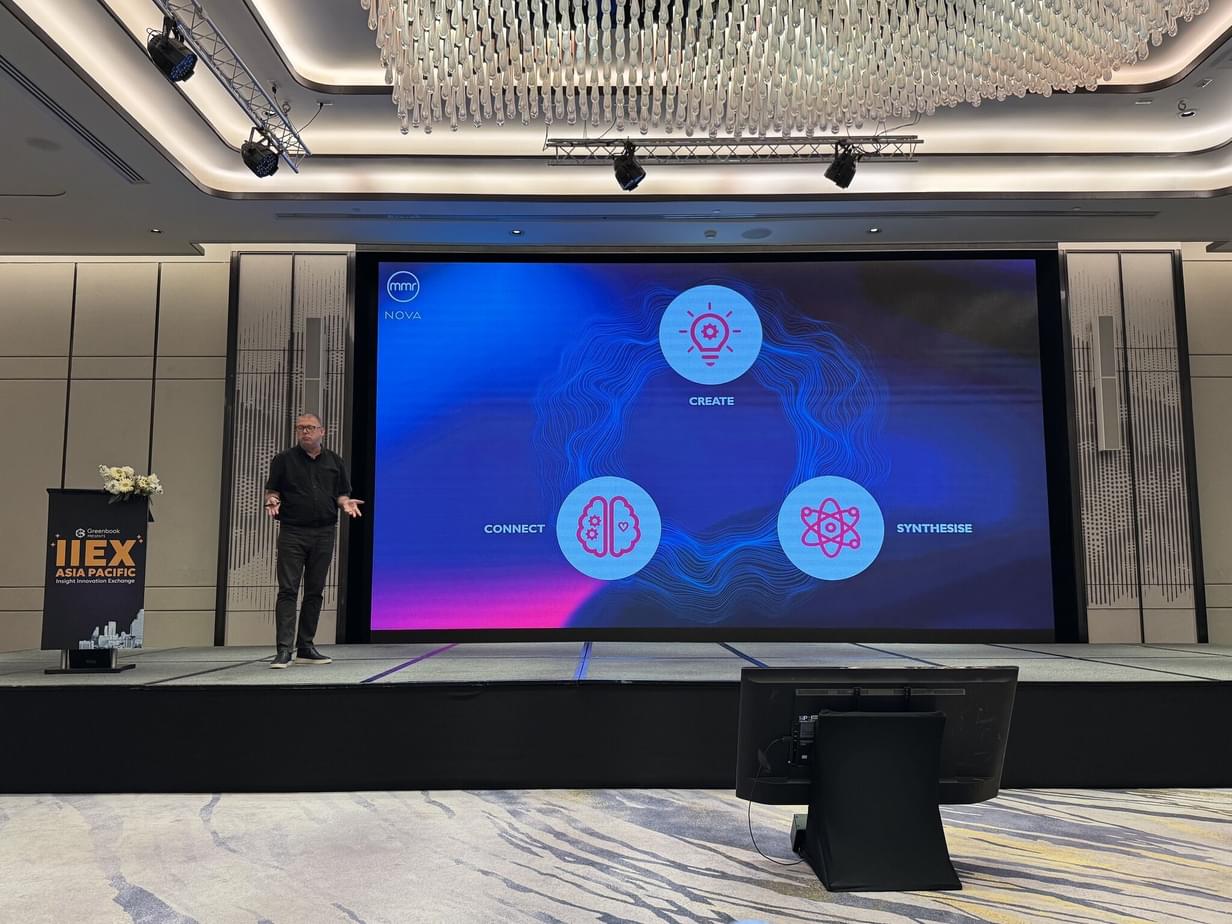Simplifying AI for Product Experience: A Framework for Faster, Better Insights

Alexandra Kuzmina
24 Mar, 2025 | 5 minutes
Navigating AI’s complexity in FMCG insights and R&D can feel overwhelming. You're constantly bombarded by suppliers promising the "next big thing," facing fragmented data sources and siloed teams, and often struggling to authentically understand what truly shapes consumer decisions in-the-moment. The real challenge is uncovering insights that foster empathy and drive impactful decisions.
To simplify this landscape and make it easier to understand where best to implement this exciting technology to maximise value, we've developed a clear, actionable framework around three essential pillars: Create, Connect, and Synthesise.
Create: Harnessing AI to innovate and translating insights into tangible outputs
Connect: Using AI to deeply engage consumers at scale, enabling more authentic and meaningful interactions.
Synthesise: Converting extensive, complex unstructured datasets into clear and actionable insights, enabling faster decision-making at scale.

AI to Connect: Enhanced Data Collection
MMR’s Conversational AI tools, particularly research chatbots, have significantly elevated how researchers engage with participants, unlocking richer insights at scale. We’ve developed these tools to capture consumer stories, feelings, and expectations:
- Survey Bot: Enhances traditional quantitative surveys by deepening responses to open-ended questions.
- Sensory Bot(coming soon!): Incorporates MMR’s specialized sensory science expertise to systematically dissect and analyze detailed product experiences.
- Q.Bot: An end-to-end chatbot engagement to amplify qualitative depth with scale.
We’ve been blown away by the versatility and impact of Q.Bot. Clients are reaping the benefits across all sorts of research scenarios, using the tool to access challenging locations and better engage with younger demographics like Gen Z and Gen Alpha.
Q.Bot's fundamentally open engagement approach helps identify what truly matters to consumers, uncovering hidden white space and innovation opportunities. Check out some of the recent use cases for Q.Bot...

Exploring functional coffee to deliver a clear action plan
BRIEF
To inspire their product innovation strategy, a large global beverage client wanted to explore the emerging functional coffee category, with a focus on a deeper understanding of the consumer context.
APPROACH
We deployed an AI-driven exploratory chatbot conversation, engaging 300 consumers across 2 markets. This conversation was designed to take a step closer to the true motivations, frustrations, and expectations that shape the decisions consumer make in the category today.
OUTCOME
Our research revealed that there is no one-size fits all functional coffee. Taste expectations and preferences vary greatly, and new functional ingredients introduce different sensory experiences. In turn, this challenges brands to choose between designing for the familiarity and safety of a traditional coffee experience or to push the flavor boundaries where there is more room for innovation and a new sensory profile. Our research guided our client to towards a clear action plan to take advantage of the opportunities this challenge presents.
In-the-moment insights to inform the client’s retail strategy
BRIEF
A global snacking company wanted to understand how consumers perceive and buy a key brand in World Travel Retail (WTR) within Heathrow Airport, and how the brand compares to other chocolates in terms of visibility, accessibility, and attractiveness. The key challenge was location as security restrictions would not allow a moderator on site.
APPROACH
We pre-recruited a global cohort of participants who would be passing through Heathrow and set up our AI powered virtual moderator to conduct individual, in-the-moment, at-fixture interviews. Using their smartphones, participants shared their experiences with Q.Bot via text and photos. The approach uses advanced Natural Language Processing to support a responsive experience with relevant probing for greater depth.
OUTCOME
We blended AI-enabled analysis with human qualitative expertise to deliver compelling and actionable insights and recommendations to inform the client’s WTR strategy for their key brand. This research approach is now being rolled out with this snacking company to capture similar learnings in other airports globally.


Understanding consumers’ experience with a new sustainable bottle
BRIEF
A global alcoholic beverages company wanted to understand how consumers experience their newly created paper packaging and how they perceive it from a sustainability perspective. The client wanted to understand this on both a quantitative and qualitative level.
APPROACH
Over 300 music festival attendees in Barcelona were given an alcoholic beverage to try, along with a QR code, inviting them to participate in a Q.Bot conversation while trying the beverage. More than 10% of those who participated in this way where then asked to discuss their experience, with a specific focus on the packaging, in more detail.
OUTCOME
Through this hybrid approach, we were able to deliver a contextually sensitive understanding of the product experience, along with consumer perspectives on sustainability and what it means to them. We were also able to differentiate between those elements of the paper packaging product experience that underpin appeal and those that limit it.
Blending Technology and Science to Enhance Consumer Product Experience Understanding
Voice in chatbots
We have already demonstrated the transformative potential of voice technology in consumer and sensory research, and voice responses are now available across all our chatbot solutions. This enables hands-free, authentic, and immediate consumer feedback, allowing participants to naturally express nuances of their product experience, enhancing empathy, accessibility, and revealing deeper insights into consumer preferences, motivations, and frustrations.
Product efficacy over time, anytime!
We've developed methods integrated seamlessly with our chatbot platforms to measure perceived product efficacy over time. Chatbots allow consumers to conveniently capture in-the-moment reactions at specified intervals, offering valuable insights such as:
- Food: Perceived levels of satiety
- Functional beverages: Changes in energy or relaxation
- Skincare: Hydration and moisture retention
- Hygiene & Personal Care: Freshness or cleanliness perception
- Household & Cleaning: Odour control and freshness
- Healthcare: Symptom or pain relief
Leveraging chatbots for this longitudinal feedback helps us answer key questions:
- How does consumer perception of product effectiveness evolve over time?
- How do usage patterns impact perceived performance?
- Are product marketing claims aligned with consumer experiences?
- How does perceived efficacy compare with competitors across usage periods?
This conversational AI-enabled approach makes capturing and analyzing dynamic in-use product experiences effortless and scalable, while ensuring deeper, continuous insights into real-world consumer perceptions.
BeSci techniques with chatbots: Future thinking & Scenario planning
We also integrate behavioural insights techniques such as Future Thinking Priming (FTP) into our chatbots. FTP significantly increases consumer engagement, prompts richer qualitative responses, and encourages participants to think more vividly and specifically about their future interactions with new product ideas. This technique has demonstrated notable success, particularly in engaging younger demographics and improving the depth of responses among traditionally harder-to-reach cohorts, like male participants or Gen Z.
We are currently piloting techniques to pressure test whether scenario-based' future thinking priming is a viable technique for testing new product prototypes. Do reach out if you’d like to know more.
The Future of AI to Connect
Looking ahead, AI will soon evolve from capturing voice responses to facilitating intelligent conversations through lifelike avatars. Initial experiments demonstrate that avatars significantly increase participant engagement, thus yielding richer, more actionable data.
Although device compatibility and consistency remain challenges, voice-enabled interactive avatars offer enormous potential for immersive, real-time exploration of consumer-product interactions.
Further into the future, continuous data streams from always-on devices such as wearable pendants or smart glasses will enable researchers to tap into constant, contextually rich streams of consumer data.

Devices designed for real-world environments, like those addressing social connectivity (e.g., "Friend"), could revolutionize real-time consumer understanding and unlock unprecedented levels of insight through continuous monitoring and interaction.
Seek ways strengthen your consumer understanding using AI on your next project. Get in touch for inspiration on how to achieve this.